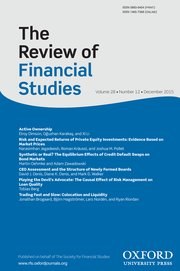
Gryglewicz, S. and Hartman-Glaser, B. (2020). Investment Timing and Incentive Costs∗ Review of Financial Studies, 33(1):309--357.
-
Affiliated author
-
Publication year2020
-
JournalReview of Financial Studies
We analyze how the costs of smoothly adjusting capital, such as incentive costs, affect investment timing. In our model, the owner of a firm holds a real option to increase a lumpy form of capital and can also smoothly adjust an incremental form of capital. Increasing the cost of incremental capital can delay or accelerate investment in lumpy capital. Incentive costs due to moral hazard are a natural source of costs for the accumulation of incremental capital. When moral hazard is severe, delaying investment in lumpy capital is costly, and overinvesting relative to the first-best case is optimal. Received January 24, 2017; editorial decision March 15, 2019 by Editor Itay Goldstein.